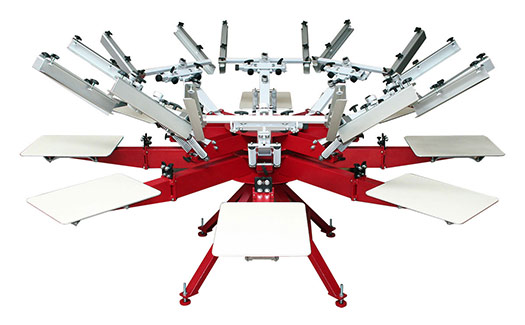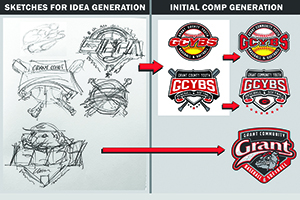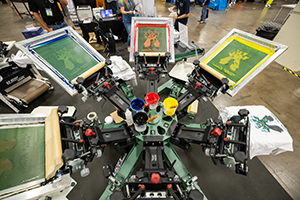September 7, 2016
Countless small-shop owners, garage-based operations, hometown printers and startup decorators make a living via the manual screen-printing process, as it remains the heart of most garment printing. Even larger, automated facilities use manual screen-printing presses for smaller orders (one to six dozen) or sampling for later production on automatic presses.
Let’s review some best practices for screen printing on a manual press.
Equipment Considerations
It never ceases to amaze me how many new people come into the industry and attend trade shows like the Imprinted Sportswear Shows (ISS) to shop for their first manual press. Although many are searching for the cheapest, easiest means to enter the industry, they’ve yet to learn the “quality-in-quality-out” lesson that applies when operating a printing press — or any piece of equipment.
Just as with the screens used, the quality of your manual press will play a huge role in your finished product. You’re better off spending extra money and purchasing a quality printer than being cheap on your initial purchase and paying for it later in the form of registration and quality issues.
Here are some features to look for when purchasing your first manual press.
Side Screen Clamps: These allow for greater stability and tighter registration.
Platen-Leveling Adjustments: Ensure proper screen/platen parallelism for front-to-back and side-to-side print consistency.
Micro-Registration Adjustments: These can be made without realigning a screen, should the need occur.
Off-Contact Adjustments: These allow the printer to achieve the proper off-contact and snap-off to ensure a clean, crisp print.
Screen-Angle Adjustments: In conjunction with the off-contact adjustments, these allow you to maintain proper screen/substrate offset.
Pnuematic Screen Clamps: These are for faster setups and tear-down times, as well as minimizing wear on the press, as most printers over-torque manual clamps.
Although some of these features may seem like overkill for a starter manual press, you will discover the initial investment is a wise one when things are operational.
Screen Quality
Some manual screen printers think all the hype regarding
higher-tension screen printing only applies to big, automated printing facilities. Truthfully, properly tensioned, high-quality screens apply to manual printers as much as — if not more than — automated facilities.
Unlike a manual press operator, an automatic press will not become tired and slow down as the day progresses. Since high-tension screens allow for less off-contact and minimal squeegee pressure, you will produce more finished garments in a day with less effort, as opposed to fighting the force needed to print through low-tension screens. Remember, similar to the purchase of the press, quality in, quality — and productivity — out.
The objective of the textile screen-printing process is to deposit the ink onto the fabric’s surface, not drive ink into it. Higher-tension screens allow this to happen with minimal effort.
Pulling vs. Pushing
The proper technique for using a squeegee has been debated for years. The simple fact is that when printing with properly tensioned screens, pushing the squeegee is far less taxing than pulling it.
When pulling the squeegee, downward force is applied by your wrist, fingertips and forearms. Although you may develop forearms like Popeye after six weeks of using the press, you still will tire far
more rapidly.
When pushing the squeegee, the force comes from your upper body and is exerted in the palms of your hands, as opposed to your forearms and fingertips. This also results in less wear on screens.
Proper squeegee angle also is a variable that easily is overlooked in manual printing. It is important to ensure you are printing with the edge of the blade and not its face.
Press Care
This is another aspect that, in many cases, is forgotten until something breaks or registration is lost. Following are some simple tips that will keep your press printing and consistently from job to job for years to come.
Keep it clean. When it comes to press performance, the manual press is no different than its expensive, automatic cousin. Ink, lint and adhesive will have the same negative effects on all its functioning aspects if not properly maintained. Keep all manual adjustments clean and properly lubricated to minimize gumming up and unnecessary wear of the moving parts. Just as with an automatic press, you should have a regular cleaning and maintenance program to maximize its life and performance
Less is more. I cannot count the number of manual presses I’ve seen where the screen-clamping knobs have been broken off due to the use of excessive force, only to be tightened with pliers. The truth is that you need a minimal amount of torque when using manual screen clamps to properly hold screens in registration. The excessive force only strips the threads of the clamps and breaks knobs.
3. Produce Samples Accurately. One aspect of manual screen printing that has been debated for years is producing samples on a manual press for later production on an automatic. The key to properly doing this is to simply not do anything that your automatic press cannot reproduce.
For example, when printing an underbase for a dark garment, do not double- or triple-stroke the image unless documented for reproduction on the automatic. Often, a pre-approved, manually printed sample cannot be accurately reproduced if the sample was tweaked during the strike-off printing in a manner that the automatic press cannot replicate.
Keeping your manual presses clean and properly maintained, and using proper printing procedures ensures a quality finished product, as well as a smooth handoff when producing samples for later production on an automatic press.
Rick Davis is a 30-year veteran of the textile manufacturing and screen printing industry. His background includes consulting, plant management, process troubleshooting. Rick also is a member of the Academy of Screen and Digital Printing Technology. For more information or to comment on this article, email Rick at rickd5050@yahoo.com
April 5, 2024 | Process + Techniques
Why do we often struggle with some of the seemingly simplest things, like slathering screen-printing ink onto a decorated-apparel garment. Slathering so that it looks clean, bright, opaque and altogether attractive.
FULL STORY
March 13, 2024 | Process + Techniques
Wouldn’t it be wonderful if there was a secret formula for designing a best-selling T-shirt for a sports team, a business or for your own pre-print line?
FULL STORY
January 25, 2024 | Process + Techniques
As is the case with any craft, when it comes to screen-printing T-shirts and other apparel the devil is in the details. The best art, the best press in the world will inevitably come up short if you don’t take care of the little things as well.
FULL STORY




